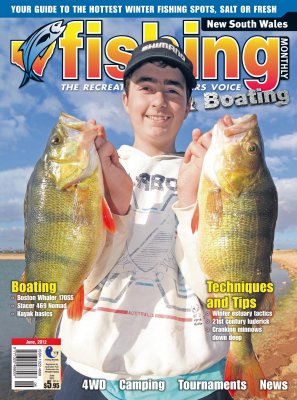Winter estuary patterns by Dan Selby
 In Winter many forms of fish life go through transitions. Some species completely shut down into hibernation, some migrate to more favourable climes and others move into our estuaries to take advantage of seasonal food, favourable water conditions or urges to reproduce.
In Winter many forms of fish life go through transitions. Some species completely shut down into hibernation, some migrate to more favourable climes and others move into our estuaries to take advantage of seasonal food, favourable water conditions or urges to reproduce.
Let's look at what Winter can offer those fishing NSW estuaries, focusing on common species, techniques that work for them and the best times to hunt them.
Australian salmon are highly rated sport fish and venture into estuaries when conditions are favourable. They most commonly can be found on an incoming tide in the lower reaches of your particular system, favouring areas of strong current adjacent to major points, drop-offs and reefs.
Salmon are easily located by monitoring bird activity around the lower reaches. Flocks of birds sitting on the surface are a good sign and a few prospective casts around the general area with a soft plastic or small metal slice should alert you to the presence of salmon.
Gulls and terns that are wheeling and diving are a far better bet when looking for active salmon. These fish generally respond best when casts are made to the leading edge of the feeding school.
A selection of metal slices from 5-40g, some small soft plastic stickbaits like the Berkeley 3" Minnows and small poppers and walkers will cover most bases.
TAILOR
Tailor are regular inshore visitors throughout the cooler months. Although large schools head north to Fraser Island to spawn in early Spring they can be intercepted off the headlands, beaches and in the lower estuaries as they stop off to terrorise local baitfish.
Tailor at times can mix with the salmon schools or can be found in their own surface-feeding schools where diving birds also will give away their location. Here they are best targeted with metal slices, poppers or hard diving lures - all give some protection against the tailor's serrated teeth.
When there are no visible signs on the surface, trolling is a very productive way of finding concentrations of tailor and salmon. Hardbodies that run shallow (.5-2m) or medium depth (3-4m) and 40-80g metal slices allow you to cover the water column and get in close to the washes where the better class of tailor and salmon wait in ambush.
Alternatively you can slowly drift at a safe distance out from the washes and cast poppers, metals or ganged pilchards/garfish for good results.
Chopper tailor (below the legal 30cm) are regular Winter visitors in the estuary and can play havoc with soft plastics aimed at other species. All is not lost, because these ravenous juveniles create a natural berley trail as they crash through the bait schools.
School jewfish, bream, silver trevally and flathead are all quite opportunistic and sit beneath the feeding choppers to pick off scraps - and the odd chopper tailor, too!
Casting soft plastics around the edges of feeding tailor schools can turn on some great fishing with a different species on each cast.
You must resist the urge to strike at the vibrating bite of the tailor, though, because this will tear the soft plastic. Just let the lure sink all the way to the bottom where a bigger predator hopefully will engulf your lure.
It's common in this situation to catch good bream, flathead and jewfish on the stub of a 4" or 5" stickbait after a tailor has bitten the tail off while it's sinking. This is exactly what these predators are looking for beneath the choppers, a disabled baitfish that is an easy meal.
BREAM
Yellowfin bream are highly sought after year round and Winter generally yields a better class of fish for those prepared to go a little lighter and a lot deeper.
The washes around headlands and breakwalls are great places to start prospecting for Winter bream.
Casting small soft plastics tight to the washes and watching the slack braid for a take is an enjoyable